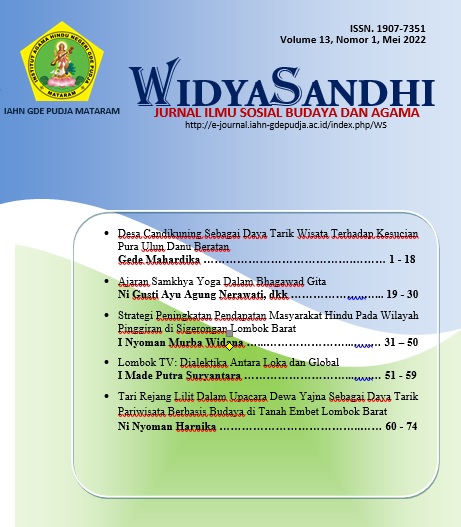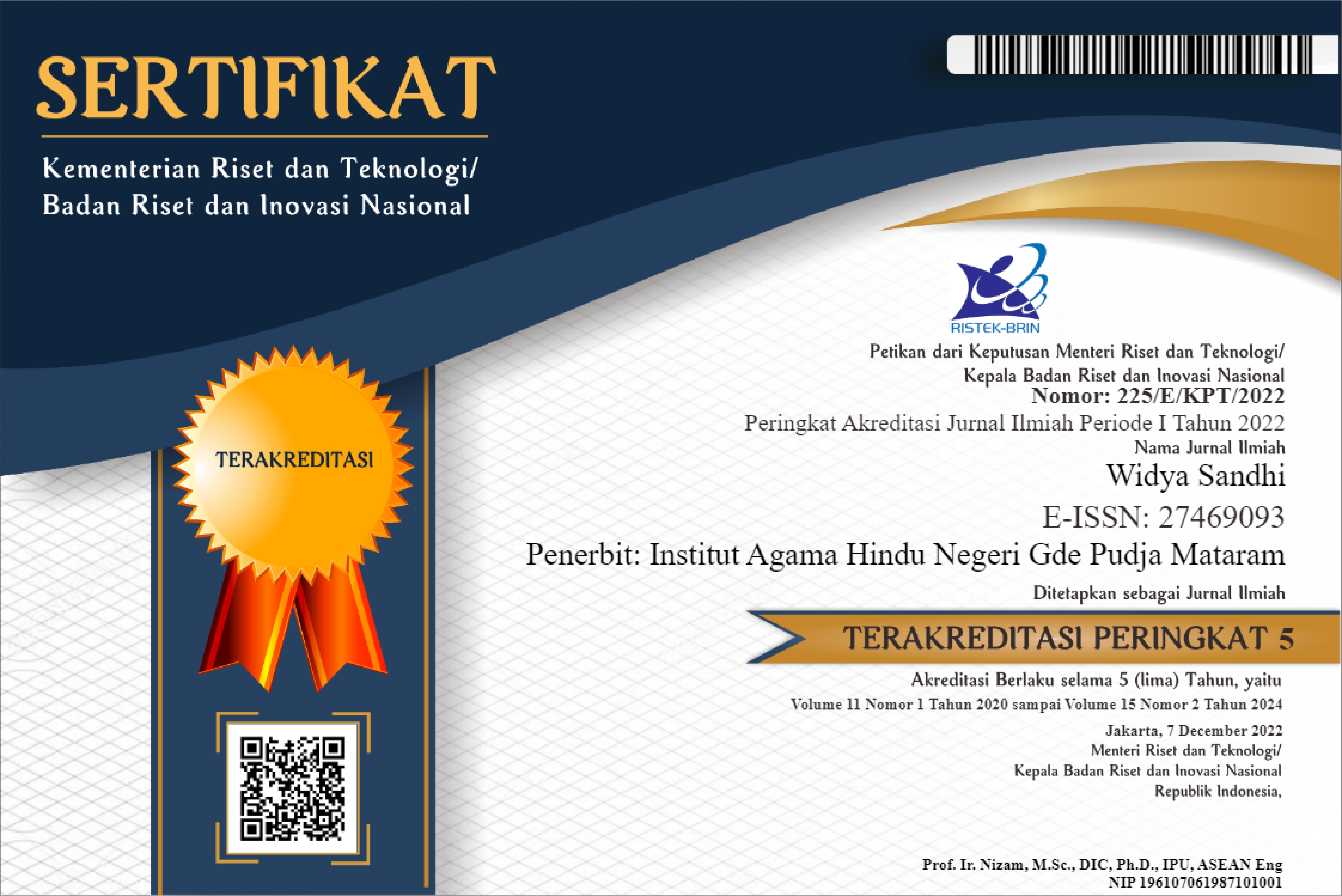TARI REJANG LILIT DALAM UPACARA DEWA YAJÑA SEBAGAI DAYA TARIK PARIWISATA BERBASIS BUDAYA DI TANAH EMBET LOMBOK BARAT
Abstract
The art of rejang lilit dance performed by Hindu women in Dusun Tanah Embet as a
complement to the dewa yajña ceremony has a very important position in carrying out
Hindu religious ceremonies. In this regard, this rejang lilit dance also has the potential to
be a cultural-based tourist attraction, especially related to the implementation of Hinduism.
This study was designed in a qualitative descriptive method in order to describe the
performance of the rejang lilit dance in relation to the implementation of Hinduism and
also as a tourist attraction. Based on the results of this study, two findings were found
related to the performance of the rejang lilit dance. First, the rejang lilit dance as one of
the sacred dance types owned by the Hindu community in Dusun Tanah Embet is very
important in completing the dewa yajña ceremony activities which are carried out in
temples managed by the Hindu community of Dusun Tanah Embet. This rejang lilit dance
61
is a form of embodiment of a sense of devotion to Ida Sang Hyang Widhi Wasa and at the
same time embodies the splendor of the implementation of the dewa yajña ceremony.
Second, the performance of the rejang lilit dance in a series of dewa yajña ceremonies also
has the potential to attract tourists visiting the area. The rejang lilit dance performance at
the time of the melasti ceremony on the beach has the potential to be watched by tourists
who are traveling in that location. In this regard, it is necessary to think ahead that this
potential can be used as an aspect in the development of cultural tourism related to the
implementation of Hinduism
References
Rineka Cipta.
Armayani, Ni Made Tausiria. 2012. Pementasan Tari Rejang lilit Pada Upacara Dewa
Yajna Di Pura Melasa Dususn Tanah Embet Kecamatan Batu Layar
Kabupaten Lombok Barat. Denpasar : Tesis IHDN.
Bandem, I Made. 1983. Enslikopedia Tari Bali. Denpasar: Akademi Seni Tari Indonesia
(Asti).
Kadri. 2011. Komunikasi Sosial Politik. Mataram: Larispa.
Moleong, Lexy J. 2002. Metodelogi Penelitian Kualitatif. Bandung: PT. Remaja
Rosdakarya.
Suamba, Ida Bagus Putu. 2007. Siwanataraja dan Estetika Hindu. Denpasar: Yayasan
Dharma Sastra
Titib , I Made. 2000. Veda Sabda Suci (Pedoman Praktis Kehidupan). Surabaya: Paramita.
Wahyuni, I Gusti Ayu. 2012. Eksistensi Pementasan Barong Landung Di Banjar Kaliungu
Kelod Kecamatan Denpasar Timur (Presfektif Pendididkan Agama Hindu).
Tesis IHDN Denpasar.
Wirawan, I. W. A. (2017). Social integration amongst communities of Balinese ethnic and
Sasak ethnic based on competence of traditional cultural at Bayan district,
north Lombok regency. International journal of linguistics, literature and
culture, 3(2), 34-44.
Wirawan, I. W. A., Sueca, I. N., Sumari, N. M., & Putra, I. G. N. K. (2019). Upakara
Panca Lingga As Symbols of Panca Dewata at Hindu Ritual Practices in
Lombok. Widya Sandhi: Jurnal Kajian Agama, Sosial dan Budaya, 10(2),
2064-2083.
Zoetmudler. J. P. 1995. Kamus Jawa Kuna Indonesia. Jakarta: PT. Gramedia Pusaka
Utama

This work is licensed under a Creative Commons Attribution-NonCommercial-ShareAlike 4.0 International License.
Authors who publish with this journal agree to the following terms:
- Authors retain copyright and grant the journal right of first publication with the work simultaneously licensed under a Creative Commons Attribution-ShareAlike 4.0 International License. that allows others to share the work with an acknowledgment of the work's authorship and initial publication in this journal.
- Authors are able to enter into separate, additional contractual arrangements for the non-exclusive distribution of the journal's published version of the work (e.g., post it to an institutional repository or publish it in a book), with an acknowledgment of its initial publication in this journal.
- Authors are permitted and encouraged to post their work online (e.g., in institutional repositories or on their website) prior to and during the submission process, as it can lead to productive exchanges, as well as earlier and greater citation of published work (See The Effect of Open Access).







.jpg)




